While the Ficus has had pride of place in many homes over the last few years, there are plenty of people looking to move their fiddle leaf fig outside. Whether it’s on a balcony or completely into your garden, it’s only fair that you’d want to spruce up your outdoor area with this beautiful plant.
But can a fiddle leaf fig live outdoors – or will the elements leave its famed glossy leaves looking a little worse for wear?
The good news is that you can have an outdoor fiddle leaf fig, although with some conditions being met. Keep reading to find out what these are and whether this will work for where you live.
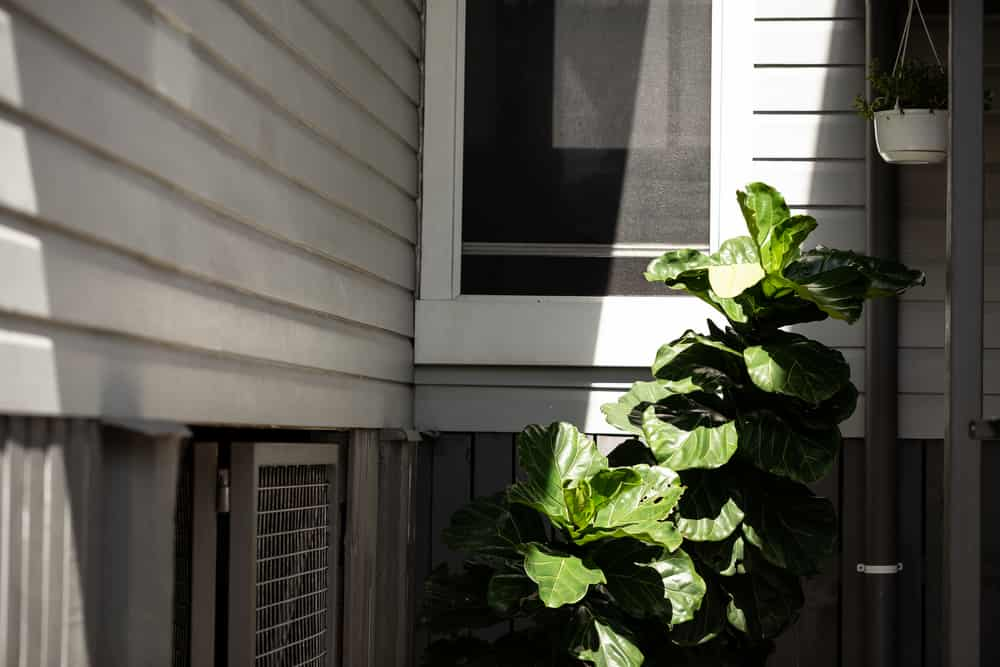
Table of Contents
Can a fiddle leaf fig live outdoors?
Yes, a fiddle leaf fig can live outdoors, but it will require some extra care. If you live somewhere with warm winters, you can keep your fiddle leaf fig outdoors all year round. However, if you live in an area with cold winters, you will need to bring your fiddle leaf fig indoors when the temperature drops below 50 degrees.
A fiddle leaf fig prefers bright, indirect light. If you keep your fiddle leaf fig outside, make sure to place it in a spot that gets plenty of sunlight but is not directly exposed to the sun’s rays.
Find out more: What Are Your Fiddle Leaf Fig’s Light Needs?
Watering a fiddle leaf fig is important, but it can be tricky. If you keep your fiddle leaf fig outdoors, make sure to water it deeply and regularly during the growing season. During the winter months, you can reduce watering to once per month.
The fiddle leaf fig plant is a tropical evergreen that originates from West Africa. It was first introduced to Europe in the 1700s and has been popular ever since. The fiddle leaf fig plant is known for its large, green leaves that have a violin-like shape.
This plant symbolizes good luck in many cultures and is often given as a gift. This makes people commonly assume it’s an indoor houseplant, but because of its tropical history, it can actually survive outdoors too.
Do fiddle leaf figs do better inside or outside?
It’s easier to control the environment of an indoor plant, which means a fiddle leaf fig will generally do better indoors. However, this doesn’t mean that a fiddle leaf fig can’t survive outdoors. With the proper care, a fiddle leaf fig can thrive outside and even grow larger than it’s indoor counterparts.
If you grow your fiddle leaf fig outdoors, you will have to find an ideal spot for it. In its natural environment, the fiddle leaf fig grows under the canopy of other trees. This means it prefers bright, indirect sunlight.
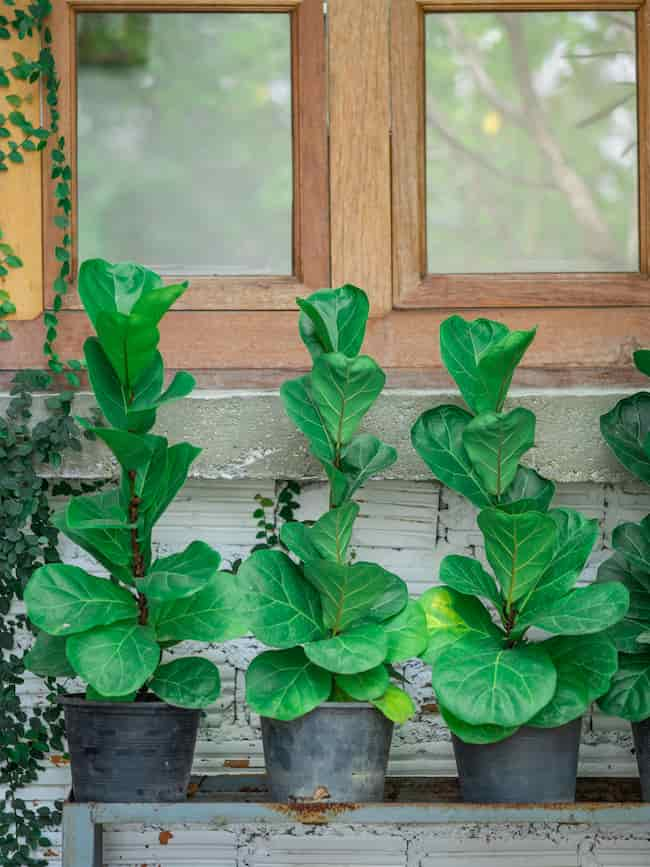
This also means that the dirt is usually lightly moistened by rain or dew. If you live in an area with a dry climate, you will need to water your fiddle leaf fig more frequently than if you lived in a humid climate.
If you can properly grow your fiddle leaf fig outside, you can increase its size by adding compost or organic matter to the soil. Fertilizing with a balanced fertilizer will also help your fiddle leaf fig to grow larger.
This may also encourage the plant to produce flowers and even let you see the growth of fiddle leaf fig tree fruit, which is rarely seen indoors. While these elements of the fiddle leaf fig are quite beautiful, keep in mind that they aren’t edible. However, you could use the seeds to grow new fiddle leaf fig plants.
Can I put my fiddle leaf fig in the rain?
Yes. The fiddle leaf fig is used to being in the rainy jungles of Africa, where rainfall is common. Because of this, this plant loves a good watering and can even tolerate being in the rain. However, it’s important that your plant’s roots can drain properly to avoid root rot.
If you live in an area with a lot of rainfall, you may not need to water your fiddle leaf fig as often. However, it’s still important to check the soil frequently to make sure it isn’t too wet or dry. Too much moisture due to overwatering your fiddle leaf fig can lead to root rot, while too little moisture can cause the leaves to dry out and drop off.
Some indicators of too much moisture are yellow or brown leaves, mold growth, and a musty earthy smell. If you notice any of these signs, try moving your plant to a drier spot and increase the amount of time between waterings.
A good way to provide your fiddle leaf fig with a balanced source of hydration is by misting its leaves. This will help to increase the humidity around your plant and can also help to keep the leaves clean.
Misting is also a good way to provide your fiddle leaf fig with the humidity it craves. If you live in a dry climate, you may need to mist your plant daily or even multiple times per day. A humidifier can also help to increase the humidity around your plant.
Can fiddle leaf fig take full sun?
The fiddle leaf fig can take full sun for a couple of hours a day at most, but it’s best to keep this plant in bright, indirect sunlight. If you leave your plant in the direct sunlight for extended periods of time, you may damage your fiddle leaf fig plant.
If you leave your fiddle leaf fig outside in direct sun all day, you may damage your plant. The leaves may become scorched or your fiddle leaf fig could get sunburnt and the plant may suffer from dehydration. The first signs of this could be white spots on your fiddle leaf fig which are an indication of burning. Soon afterwards, these patches will turn brown and the leaf as a whole may turn yellow and dry out while drooping.
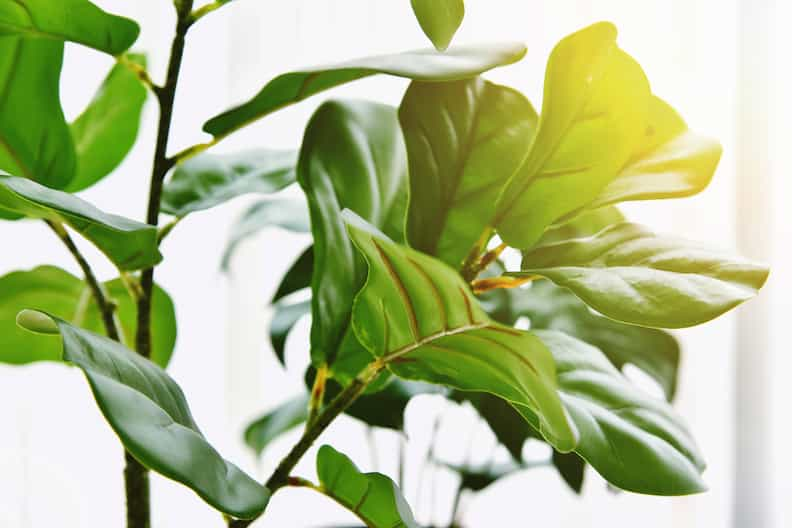
Eventually, the leaves will drop off because the plant is trying to conserve water and energy. If this happens, you can try to revive your fiddle leaf fig by giving it a deep watering and moving it to a shadier spot.
If you’re growing your plant indoors, try to place it near a bright window where it will get indirect sunlight. If you’re growing your plant outdoors, place it under the canopy of another tree or in a spot where it will only get direct sunlight for a couple of hours each day.
It’s also important to make sure your fiddle fig leaf plant gets enough light. This plant doesn’t do well in low-lighting conditions and will start to lose its leaves and will halt its growth. If you notice your plant isn’t getting enough light, try moving it to a brighter spot.
How cold can fiddle leaf fig tolerate outside?
Fiddle leaf figs are not cold-hardy, so if you live in an area with temperatures that dip below 55 degrees Fahrenheit, you will need to bring your plant indoors for the winter. You will also need to be mindful to bring it in during cold nights and on days when there is a chance of frost.
When bringing your outdoor fiddle leaf fig indoors for the winter, make sure to place it in a spot where it will get bright, indirect sunlight. Make sure that there aren’t any drafts in the area, as this can cause the leaves to dry out.
You should also avoid placing your plant directly in the path of your air conditioning or heating vents, as this can also affect the ideal temperature conditions for your fiddle leaf fig.
When it comes to heat, this plant can tolerate a maximum temperature of about 85 to 90 degrees Fahrenheit. However, it’s important to make sure that the plant doesn’t get too hot, as this can cause the leaves to dry out and drop off.
If you live in an area with extreme temperatures, it’s best to keep your fiddle leaf fig indoors all year round. This will help to ensure that your plant stays healthy and doesn’t experience any temperature-related stress.
When can I bring my fiddle leaf fig tree outside?
You can bring your fiddle leaf fig outside when the temperatures are consistently above 55 degrees Fahrenheit. You can track the temperature using a weather app or website, or you can use a garden thermometer to measure the temperature in your area. This will ensure that your plant doesn’t experience any temperature-related stress.
You should also make sure to set up your home’s environment to be as ideal for your outdoor fiddle leaf fig as possible.
If you’re placing the plant on your patio, make sure that it’s in a spot where it will get bright, indirect sunlight. You should also check the area for drafts and make sure that there aren’t any vents blowing hot or cold air directly on the plant.
When placing your fiddle leaf fig in the backyard, make sure that it’s in a spot that doesn’t get too much sun. Too much direct sunlight can cause the leaves to scorch, so it’s important to find a balance. You should also make sure that the plant is in an area with well-drained soil to avoid root rot.
Related: What’s the Best Soil for Fiddle Leaf Figs to Thrive?
It’s ok to bring your plant outdoors when it’s rainy, as long as you’re using a pot that drains well. Humid warm days are perfect conditions for your plant to get the moisture it needs from the air.
How do I move an indoor fiddle leaf fig outdoors?
The best way to move an indoor fiddle leaf fig outdoors is to do it gradually and with lots of observation. It takes time for this plant to adjust to a new environment without experiencing a shock. So, the process should be done slowly over the course of a week or two.
Here are a few steps that you can follow for a safe transition:
1. Replant your fiddle leaf fig
The first step is to replant your fiddle leaf fig in a pot that’s large enough to accommodate its root ball. You should also make sure that the pot has drainage holes to avoid root rot.
It will likely grow faster and larger when it’s outdoors, so you may need to replant it in a larger pot every few years. Repotting your fiddle leaf fig plant with fresh soil also ensures that it’s getting the nutrients it needs to thrive.
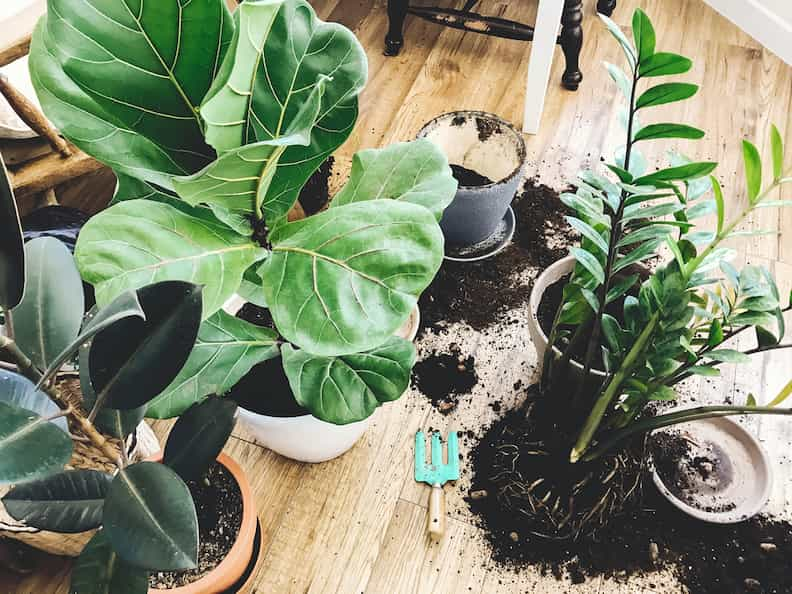
2. Introduce it to the outdoors gradually
Once your plant is replanted, you can start to introduce it to the outdoors gradually. Start by placing it in a spot where it will get indirect sunlight for a few hours each day. You should also make sure that the temperature is above 55 degrees Fahrenheit and, ideally, it’s between 70 to 80 degrees.
Do this during the late morning or early evening to avoid the hottest part of the day. You can also provide some protection from the sun by placing a sheer curtain or fabric over the plant.
3. Increase the length of time you leave your plant outside
After a few days, you can increase the amount of time that your plant is outdoors each day. You should also start to increase the amount of direct sunlight it’s getting each day, but only by a few minutes to avoid damage.
4. Find a permanent outdoor home for your plant
Now that your fiddle leaf fig has adapted to the outdoors, you can find it a permanent home in your garden or on your patio. Make sure to choose a spot that gets bright, indirect sunlight.
5. Take care of your outdoor plant properly
Once you’ve found the perfect spot for your plant, it’s important to take care of it properly. This includes watering it when the soil is dry and fertilizing your fiddle leaf fig every few months. You should also keep an eye on the weather in case it needs to be brought indoors.
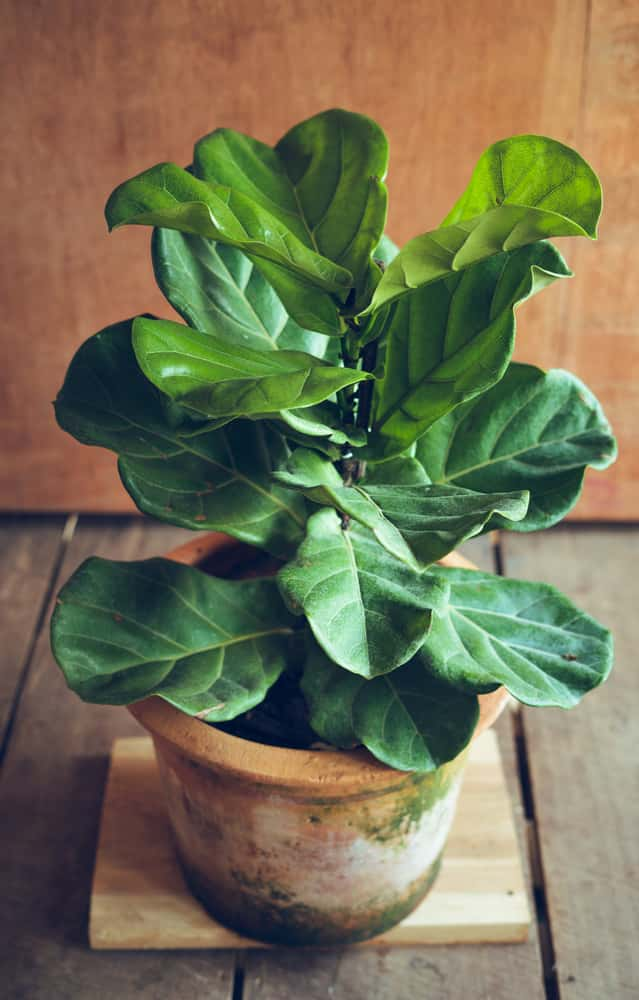
When should I bring an outdoor fiddle leaf fig inside?
Some of the most important times to bring your fiddle leaf fig indoors are during storms with extreme wind, below-freezing temperatures, heat waves, and powerful rainstorms. This will ensure that your plant is protected from the elements and doesn’t experience any damage.
You can also watch and listen to your plant to know when it’s not happy. You can tell that your fiddle leaf fig is stressed outdoors if it starts to drop leaves or if its leaves start to turn yellow.
It’s also possible that a pest infestation could occur when your plant is outdoors. If you see any insects on your plant, use a natural pesticide to get rid of them.
In general, it’s a good idea to bring your fiddle leaf fig indoors during the winter months. This will help it to stay healthy and avoid any damage from the cold weather.
Where should I place my fiddle leaf fig outdoors?
The most important consideration when putting your fiddle leaf fig outdoors is its sun exposure. These plants enjoy a lot of light, but they won’t do well in consistent direct light. This is especially true if you live in a region that gets very hot summers, so find areas with diffused light that are protected from the hottest sun.
Another important factor is wind protection. Fiddle leaf figs are native to tropical rainforests, so they don’t do well in windy conditions. If you live in a windy area, find a spot that’s sheltered from the wind or place your plant in a pot so that it can be moved indoors. Some great barriers to wind include fences, walls, and hedges.
You should also make sure that your plant is in a spot with good drainage. These plants don’t like to sit in wet soil, so find an area where the water will drain away quickly. If you live in a region with heavy rain, it’s especially important to make sure your plant is in a spot where the water won’t pool around it.

How to care for a fiddle leaf fig outdoors
When you’ve found the perfect spot for your fiddle leaf fig outside, it’s important to take care of it properly. Here are some tips for caring for your plant outdoors:
1. Water your plant correctly
These plants need a lot of water, so make sure to keep the soil moist. However, you should also avoid overwatering, which can lead to root rot in your fiddle leaf fig.
Fertilize your plant every few months. Use a fertilizer made specifically for fiddle leaf figs or another type of tropical plant.
Find out more: How Often Should You Water a Fiddle Leaf Fig?
2. Monitor the weather conditions
Be sure to bring your plant indoors during extreme weather conditions, such as storms with high winds, freezing temperatures, heat waves, or powerful rainstorms.
3. Check for pests
Keep an eye out for pests. Outdoor fiddle leaf fig plants are especially susceptible to mealybugs, spider mites, and scale insects. If you see any of these pests on your plants, use a natural pesticide to get rid of them.
4. Monitor the sunlight around your home
Fiddle leaf figs need a lot of light, but they shouldn’t be in direct sunlight. If you live in an area with very hot summers, make sure to find a spot that has diffused light.
The light may move throughout the seasons, so make sure that you adjust your plant’s location accordingly. You can also diffuse the light by placing a structure like a screen, fence, or wall between the plant and the sun.
